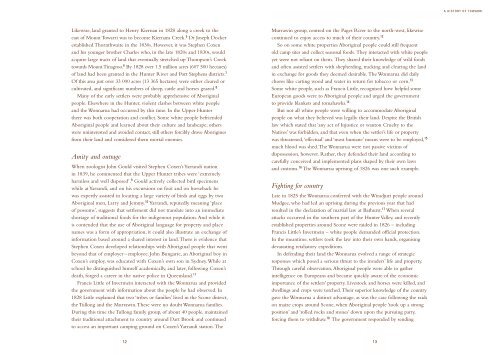Remembering Country: History & Memories of Towarri National Park ...
Remembering Country: History & Memories of Towarri National Park ...
Remembering Country: History & Memories of Towarri National Park ...
You also want an ePaper? Increase the reach of your titles
YUMPU automatically turns print PDFs into web optimized ePapers that Google loves.
Likewise, land granted to Henry Kiernan in 1828 along a creek to the<br />
east <strong>of</strong> Mount <strong>Towarri</strong> was to become Kiernans Creek. 5 Dr Joseph Docker<br />
established Thornthwaite in the 1830s. However, it was Stephen Coxen<br />
and his younger brother Charles who, in the late 1820s and 1830s, would<br />
acquire large tracts <strong>of</strong> land that eventually stretched up Thompson’s Creek<br />
towards Mount Tinagroo. 6 By 1828 over 1.5 million acres (607 500 hectares)<br />
<strong>of</strong> land had been granted in the Hunter River and Port Stephens districts. 7<br />
Of this area just over 33 000 acres (13 365 hectares) were either cleared or<br />
cultivated, and significant numbers <strong>of</strong> sheep, cattle and horses grazed. 8<br />
Many <strong>of</strong> the early settlers were probably apprehensive <strong>of</strong> Aboriginal<br />
people. Elsewhere in the Hunter, violent clashes between white people<br />
and the Wonnarua had occurred by this time. In the Upper Hunter<br />
there was both cooperation and conflict. Some white people befriended<br />
Aboriginal people and learned about their culture and landscape; others<br />
were uninterested and avoided contact, still others forcibly drove Aborigines<br />
from their land and considered them mortal enemies.<br />
Amity and outrage<br />
When zoologist John Gould visited Stephen Coxen’s Yarrandi station<br />
in 1839, he commented that the Upper Hunter tribes were ‘extremely<br />
harmless and well disposed’. 9 Gould actively collected bird specimens<br />
while at Yarrandi, and on his excursions on foot and on horseback he<br />
was expertly assisted in locating a large variety <strong>of</strong> birds and eggs by two<br />
Aboriginal men, Larry and Jemmy. 10 Yarrandi, reputedly meaning ‘place<br />
<strong>of</strong> possums’, suggests that settlement did not translate into an immediate<br />
shortage <strong>of</strong> traditional foods for the indigenous population. And while it<br />
is contended that the use <strong>of</strong> Aboriginal language for property and place<br />
names was a form <strong>of</strong> appropriation, it could also illustrate an exchange <strong>of</strong><br />
information based around a shared interest in land.There is evidence that<br />
Stephen Coxen developed relationships with Aboriginal people that went<br />
beyond that <strong>of</strong> employer – employee. John Bungarie, an Aboriginal boy in<br />
Coxen’s employ, was educated with Coxen’s own son in Sydney.While at<br />
school he distinguished himself academically, and later, following Coxen’s<br />
death, forged a career in the native police in Queensland. 11<br />
Francis Little <strong>of</strong> Invermein interacted with the Wonnarua and provided<br />
the government with information about the people he had observed. In<br />
1828 Little explained that two ‘tribes or families’ lived in the Scone district,<br />
the Tullong and the Murrawin.These were no doubt Wonnarua families.<br />
During this time the Tullong family group, <strong>of</strong> about 40 people, maintained<br />
their traditional attachment to country around Dart Brook and continued<br />
to access an important camping ground on Coxen’s Yarrandi station.The<br />
12<br />
Murrawin group, centred on the Pages River to the north-west, likewise<br />
continued to enjoy access to much <strong>of</strong> their country. 12<br />
So on some white properties Aboriginal people could still frequent<br />
old camp sites and collect seasonal foods. They interacted with white people<br />
yet were not reliant on them. They shared their knowledge <strong>of</strong> wild foods<br />
and <strong>of</strong>ten assisted settlers with shepherding, tracking and clearing the land<br />
in exchange for goods they deemed desirable. The Wonnarua did daily<br />
chores like carting wood and water in return for tobacco or corn. 13<br />
Some white people, such as Francis Little, recognised how helpful some<br />
European goods were to Aboriginal people and urged the government<br />
to provide blankets and tomahawks. 14<br />
But not all white people were willing to accommodate Aboriginal<br />
people on what they believed was legally their land. Despite the British<br />
law which stated that ‘any act <strong>of</strong> Injustice or wanton Cruelty to the<br />
Natives’ was forbidden, and that even when the settler’s life or property<br />
was threatened,‘effectual’ and ‘most humane’ means were to be employed, 15<br />
much blood was shed.The Wonnarua were not passive victims <strong>of</strong><br />
dispossession, however. Rather, they defended their land according to<br />
carefully conceived and implemented plans shaped by their own laws<br />
and customs. 16 The Wonnarua uprising <strong>of</strong> 1826 was one such example.<br />
Fighting for country<br />
Late in 1825 the Wonnarua conferred with the Wiradjuri people around<br />
Mudgee, who had led an uprising during the previous year that had<br />
resulted in the declaration <strong>of</strong> martial law at Bathurst. 17 When several<br />
attacks occurred in the southern part <strong>of</strong> the Hunter Valley, and recently<br />
established properties around Scone were raided in 1826 – including<br />
Francis Little’s Invermein – white people demanded <strong>of</strong>ficial protection.<br />
In the meantime, settlers took the law into their own hands, organising<br />
devastating retaliatory expeditions.<br />
In defending their land the Wonnarua evolved a range <strong>of</strong> strategic<br />
responses which posed a serious threat to the invaders’ life and property.<br />
Through careful observation, Aboriginal people were able to gather<br />
intelligence on Europeans and became quickly aware <strong>of</strong> the economic<br />
importance <strong>of</strong> the settlers’ property. Livestock and horses were killed, and<br />
dwellings and crops were torched. Their superior knowledge <strong>of</strong> the country<br />
gave the Wonnarua a distinct advantage, as was the case following the raids<br />
on maize crops around Scone, when Aboriginal people ‘took up a strong<br />
position’ and ‘rolled rocks and stones’ down upon the pursuing party,<br />
forcing them to withdraw. 18 The government responded by sending<br />
13<br />
A HISTORY OF TOWARRI

















